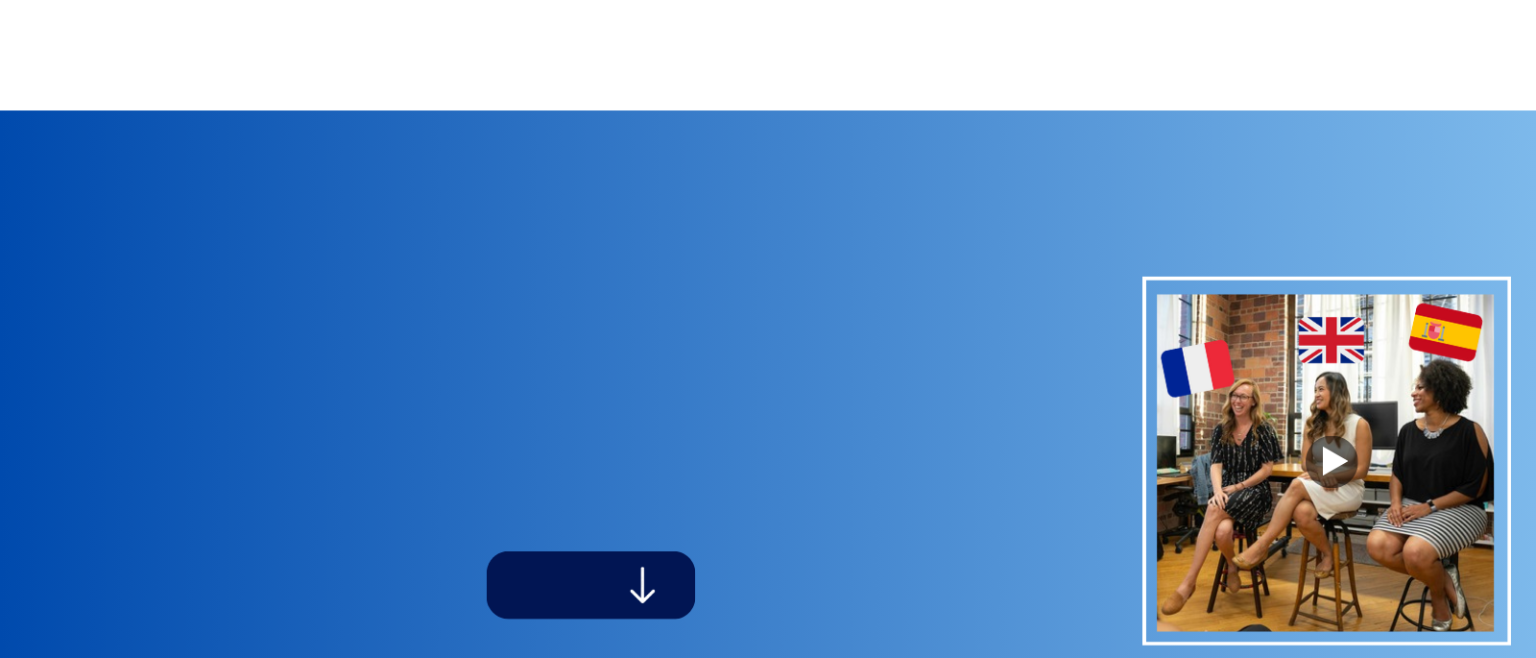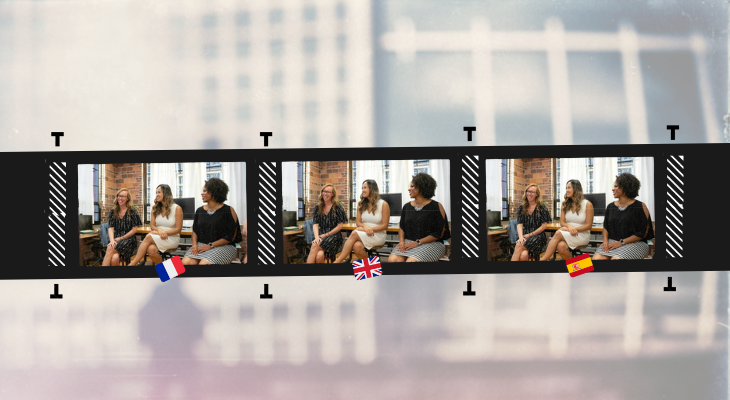IBC 2025 | Meet us in Amsterdam from 12 to15 september 2025

How to easily translate and subtitle a video that contains
several languages?
25 October 2024
12 Mars 2019
LLOREM IPSUM DOLOR SIT AMET, CONSECTETUR
ADIPISICING ELIT SED DO EIUSMOD
Are you a producer, broadcaster or content creator who has to deal with videos containing several languages?
Interviews, documentaries, films, series, etc., there are more and more videos in which several people speak different languages. The world of sport is a good example: the coach speaks one language, the players another and the commentators yet another.
How can you optimise the subtitling of this type of video without it becoming a time-consuming and costly headache? 🤔
In this article, we present 3 solutions, their advantages and disadvantages:
- call on as many transcribers/translators as there are languages in your video,
- cutting up your video and using automatic translation tools,
- using Eolementhe's AI, which automatically detects the languages in your video, translates them and generates your subtitles Translated with DeepL.com (free version)
1. The challenge of multilingual videos
LLOREM IPSUM DOLOR SIT AMET, CONSECTETUR
ADIPISICING ELIT SED DO EIUSMOD
When a video contains speakers of different languages, video editors are often faced with complex tasks: - identifying each language
- transcribing the speech using transcribers who master each language
- translating using translators who master each language pair,
- synchronising the subtitles
This process is long, tedious, costly and prone to human error. What's more, manual subtitle management becomes even more tricky when the languages used are unfamiliar to the team in charge of the project.
2. What are the solutions for translating and subtitling a multilingual video?
2.1 Using specialist (human) translators
The ‘traditional’ method involves using translation agencies or freelance translators who specialise in each language present in the video.
Each translator listens to the parts where a specific language is spoken, transcribes them and then translates them into the target language. The subtitles then have to be manually synchronised by a video editor and then embedded in the video.
Advantages:
- Linguistic and cultural accuracy: human translators take into account cultural and contextual nuances, making the translation very faithful to the original message.
- Flexibility in adaptation: translators can adjust content, make sentences more fluid or localise cultural references for the target audience.
- Guaranteed quality: professional translators are experienced in the field and can provide top-quality translations, especially for complex or thematically-specific videos.
Disadvantages:
- High cost: hiring several translators for different languages, and especially different language pairs (e.g. finding a translator who masters Malawian transcription and Italian translation? no easy task!) can be very costly, especially if the video is long or complex.
- Processing time: this process is manual and can take a long time, especially if there are a lot of languages to process. Not to mention the time needed to adjust the time codes for subtitling!
- Risk of inconsistency: if several translators are working in parallel, there may be inconsistencies in the tone, style or terminology used in the video.
LOREM IPSUM DOLOR
Lorem ipsum dolor sit amet, consectetur adipisicing elit, sed do eiusmod tempor incididunt ut labore et dolore magna aliqua. Ut enim ad minim veniam, quis nostrud exercitation ullamco laboris nisi ut aliquip ex ea commodo consequat.
12 Mars 2019
2.2 Dividing the video by language and using automatic translation tools
Another solution is to divide the video into several segments, each corresponding to a specific language. Each segment is then processed by an automatic translation tool (such as Google Translate, DeepL, etc).
This allows languages to be managed separately and avoids several languages being confused by the same algorithm.
Advantages :
- Low cost: using automatic tools is less expensive than using several human translators
- Speed: automatic tools process the translation quickly and can deliver a result in just a few minutes.
- Language management: this method allows you to control the translation of each language separately and avoid errors caused by confusion between several languages.
Disadvantages :
- Time-consuming: this option for cutting videos can still be time-consuming, especially as you will then have to re-edit the video to put the different sequences together.
- Variable quality: the automatic tools may lack precision, particularly for complex sentences or important linguistic nuances. Machine translation may also be less fluid than that produced by a human.
- Manual synchronisation required: even if the translation is fast, the subtitles will have to be manually synchronised with the audio, which can be time-consuming.
12 Mars 2019
2.3 Using a subtitling platform that manages multiple languages in the same video
This is where Eolementhe comes in. Our platform exploits the potential of artificial intelligence (AI) to automate the translation and subtitling of videos with multiple languages present.
In concrete terms:
1. Upload your video and specify the language you want it translated into
2. Eolementhe's AI analyses the video and automatically detects the different languages spoken in each segment of the video (10 languages are currently supported: German, English, Spanish, French, Italian, Japanese, Portuguese, Russian and Chinese).
3. Automatic translation: once the languages have been detected, Eolementhe automatically translates the text into the target language, for example English. Thanks to advanced natural language processing algorithms, this translation is both fast and accurate.
4. Subtitle generation with time-codes: subtitles are also generated by the platform, with trimming and time-codes. A simple, comprehensive review interface enables several users to work together to proofread, correct and validate the translation.
In the video below, 10 languages are spoken. The Eolementhe AI detected them, then automatically translated them into English!
Lorem ipsum dolor
Lorem ipsum dolor sit amet, consectetur adipisicing elit, sed do eiusmod tempor incididunt ut labore et dolore magna aliqua. Ut enim ad minim veniam, quis nostrud exercitation ullamco laboris nisi ut aliquip ex ea commodo consequat.
12 Mars 2019
LLorem ipsum dolor sit amet, consectetur
adipisicing elit sed do eiusmod
Using the Eolementhe platform offers several key advantages:
- Significant time savings: the automation of language detection and translation drastically reduces production times.
- Accuracy and quality: thanks to advances in AI and neural networks, transcription and translation are highly accurate, minimising errors that could occur during manual input.
- Multi-language management: our platform can handle videos where several languages coexist. This makes the solution accessible, even for teams who don't master all the languages in a video.
- Flexibility and customisation: the subtitles generated can be exported in different formats, depending on specific needs (SRT, STL, etc.). Eolementhe also allows subtitles to be edited manually if adjustments are required, guaranteeing total flexibility.
Your professional subtitles on Eolementhe
Entrust us with your subtitling work: automatically generated transcription and translation, with post-editing by our professional translators.

